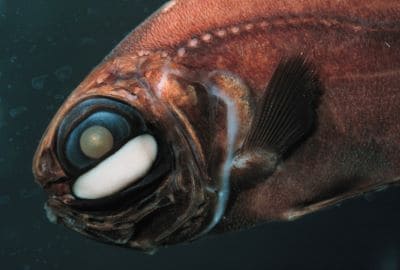Home › Ocean Species › Marine Animals › Vertebrates › Flashlight Fish
Interesting Facts about Flashlight Fish
[Phylum: Chordata] [Class: Actinopterygii (bony-fish)] [Order: Beryciformes] [Family: Anomalopidae]
The anomalopid flashlight fish (also called lantern-eye fish) is a unique species closely related to squirrelfishes and roughies (slimeheads).
This section contains some of the lesser known facts and information about the flashlight fish species and how this nocturnal carnivore uses luminescent organs to confuse its predators.
Flashlightfishes Unique Traits & Appearance
There aren't many shallow-water species that can produce luminescent light like the Anomalopidae fish families.
So, why are they called flashlight fish? In fact, the name refers to large light organs located underneath their eye sockets.
In the main, they are nocturnal creatures - hiding inside small holes in the reef or in dark underwater caves.
Hence, you may need to become a scuba diver to observe them during the daylight hours.
Nonetheless, when darkness falls the flashlight fish can manipulate its muscular skin flaps. This descendent of a deep-sea lineage uses them to communicate by hiding (or by revealing) bioluminescent light.
As a matter of fact, it is the presence of bioluminescent bacteria that creates the continuous light. Even so, each of the three lantern-eye fish species has a mechanism for decreasing the glow of luminescence (e.g. using a blinking effect to cover or uncover the light).
Flashlight Fish Habitat and Distribution
Two of the genus exist in the tropical marine habitats of the Indo-Pacific region. Whereas, the third species lives in certain areas of the Caribbean.
Even the adult flashlight fishes will grow no longer than thirty (30) centimetres (12 inches). Outside of aquariums, you may catch sight of them living around coral reef formations or other natural structures that offer shelter, such as rocky outcrops.
 It's a rare species. But they are related to other more common specimens, including fangtooths, squirrel fish, and slimehead fish.
It's a rare species. But they are related to other more common specimens, including fangtooths, squirrel fish, and slimehead fish.
Like many marine vertebrates and invertebrates, the species is vulnerable to certain phenomena, including:
- Acidification in the oceans
- Capture for the fishkeeping aquarium trade
- Destructive fishing
- Effects of climate change
- Underwater garbage pollution
Important: Inhabiting the coral reef formations in the warm waters of the Pacific regions means the fate of the species is linked to its natural ecosystem.
Types of Flashlight Fish Species
One-fin Flashlight Fish (Photoblepharon palpebratum)
Red Sea Flashlight Fish (Photoblepharon steinitzi)
Splitfin Flashlight Fish (Anomalops katoptron)
What Do Flashlight Fish Eat?
Being a nocturnal species, flashlight fishes feed after the sun has gone down. Scientists believe they use the black membranes and light emitting organs to help locate food, including:
- Crustaceans (especially shrimp)
- Planktonic prey
- Small fishes
- Zooplankton
The IUCN Red List considers the flashlight fish as being of 'Least Concern'. Nonetheless, even though humans do not eat the flesh, they do capture them for use in public and private aquariums.
Fun Facts about Flashlightfishes
The following information enhances the mahi-mahi fish species facts guide with short snippets of unfamiliar data and educational research.
- The three species that fall under the family Anomalopidae are Anomalops katoptron (Splitfin flashlight fish), Photoblepharon palpebratum (Eyelight fish), and Photoblepharon steinitzi.
- Flashlight fish can flash their bean-shaped, lantern-eye lights up to fifty (50) times per minute and can be seen from over thirty (30) metres away (100 feet). We understand it is the brightest among all of the bioluminescent creatures.
- Even though most of the species have dark coloured bodies, the smallest flashlight fish can measure less than twelve (12) centimetres long (5 inches).
- They will blink the light and swim in one direction, then turn it off and swim in another direction - to try and confuse (or divert) their predators.
Related Information and Help Guides
- Bull Sharks Facts and Information with Pictures
- Grouper Fish Species Description and Characteristics
- Is it Bad for Scuba Divers to Feed Fishes?
- List of Marine Vertebrates Examples for Beginners
- Where is a Good Dive Site to See Cobia Fish Species?
Pro Tip: The short video [2:31 minutes] presented by 'Deep Marine Scenes' contains more flashlight fish facts, the spooky fish that glows in the dark, including some footage about other fish with flashlight and the lanterneye fish.